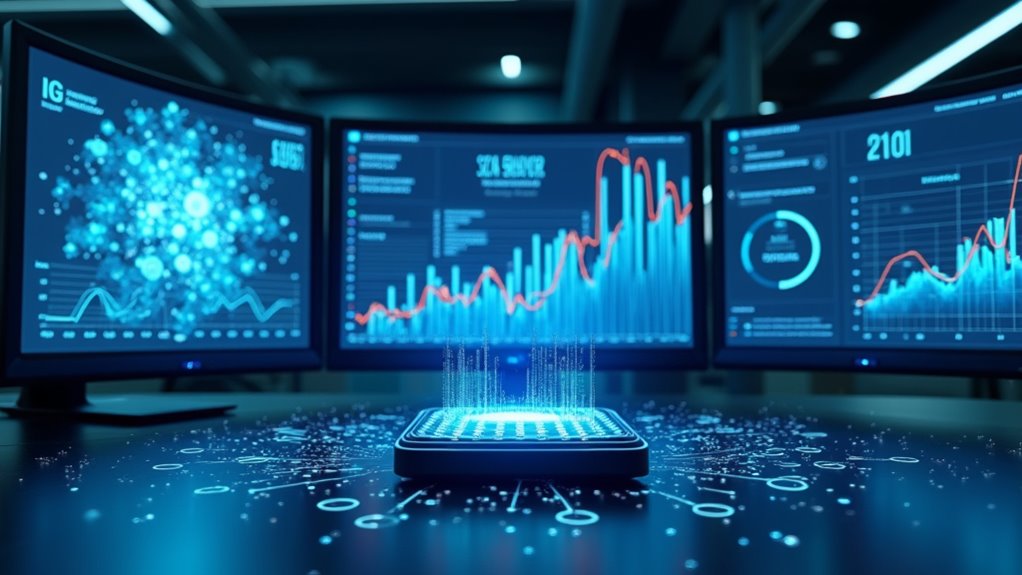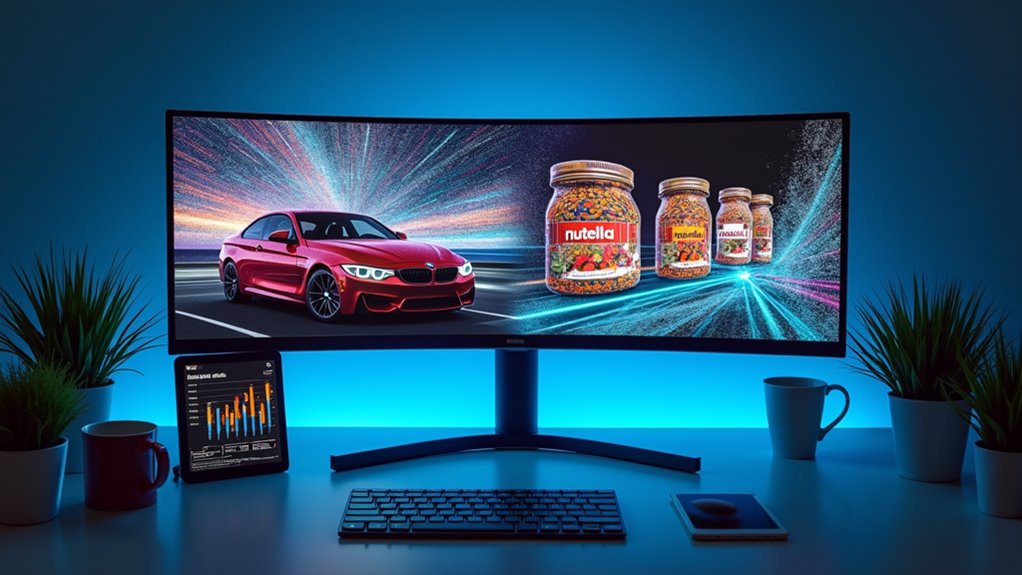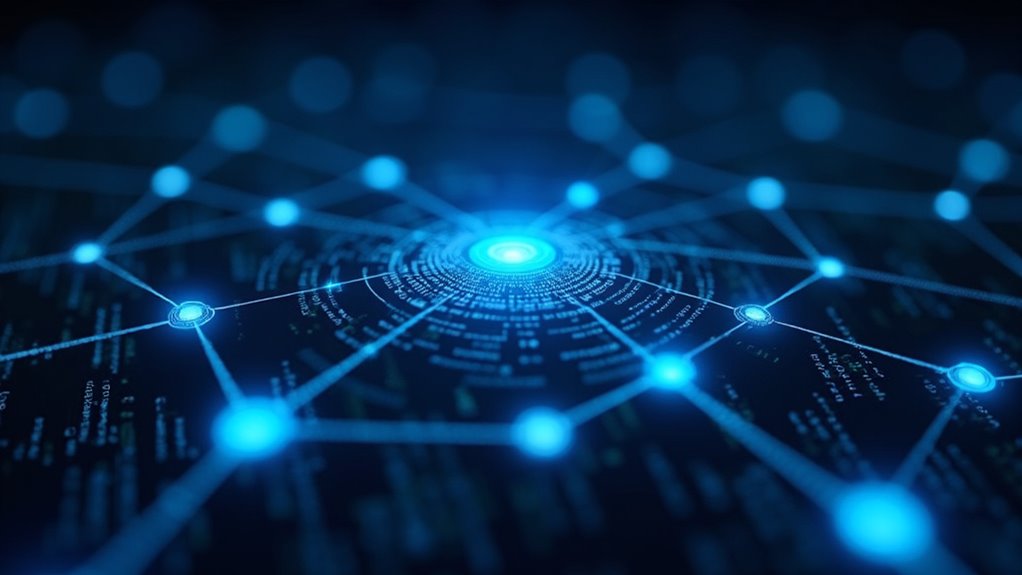AI is revolutionizing digital advertising by automating creative tasks, analyzing audience behavior, and optimizing ad placements in real-time. What used to require massive teams now happens with a few clicks. Smart marketers leverage AI for personalized content that boosts conversions while slashing costs—up to 25% savings with better results. Tools like Phrasee generate superior copy, while programmatic AI serves as your marketing psychic, predicting exactly when and where ads will perform best. Dive deeper to access these game-changing advantages.

Revolution isn’t just coming to advertising—it’s already here. Artificial intelligence has firmly planted its digital feet in the marketing landscape, transforming how brands connect with consumers. Creative automation now handles tasks that once required entire teams of designers and copywriters. These AI platforms, like Smartly, scale creative content across multiple screens without breaking a sweat—or a budget.
AI has transformed marketing, automating creative tasks that once required entire teams—scaling content without breaking budgets.
Meanwhile, audience insights derived from AI analysis tell marketers exactly who’s watching, clicking, and buying. The days of shooting expensive ads into the void and hoping for the best? Gone. Successful AI implementation requires strategic balance between cutting-edge technology and human creative input.
The programmatic advertising revolution operates behind the scenes, making split-second decisions about ad placements that human media buyers could never match. When Kellogg’s implemented AI-driven programmatic strategies, their performance metrics jumped dramatically. Why? Because AI optimizes in real-time, placing ads precisely when and where your potential customers are most receptive. It’s like having a marketing psychic on your payroll, minus the crystal ball and mysterious scarves.
Want better ads? AI’s got that covered too. Predictive Creative Optimization analyzes thousands of data points to determine which ad elements will perform best before you spend a dime. Tools like Phrasee generate copy that outperforms human-written alternatives by analyzing what language patterns trigger consumer action. It’s not replacing creativity—it’s supercharging it. The integration of AI in marketing creates highly personalized customer interactions that significantly boost engagement and conversion rates.
The targeting capabilities get downright spooky. NLP sentiment analysis reads consumer conversations to gauge feelings about your brand. Computer vision spots your competitor’s logo in a video and serves your ad immediately after. P&G famously used AI segmentation to generate $10M in additional revenue by finding audience segments human analysts missed.
Perhaps most importantly, AI slashes wasted ad spend. Real-time bidding systems make certain you’re never overpaying for impressions, while cross-channel optimization tools redistribute budgets to wherever they’re performing best. The result? Up to 25% cost reduction with improved performance. AI-driven supervised learning algorithms continuously improve by analyzing labeled data from previous campaigns, making each advertising effort more efficient than the last. In today’s economy, who can afford to ignore that math?
Frequently Asked Questions
How Much Does Implementing AI Advertising Typically Cost?
Implementing AI advertising solutions isn’t cheap, folks. The cost breakdown typically includes $5,000-$30,000 for initial setup, plus ongoing monthly expenses of $1,000-$5,000.
Budget considerations should factor in software licenses, cloud computing costs, and potential development services. Custom solutions can skyrocket to $100,000+ depending on complexity.
Can AI Advertising Solutions Work for Small Businesses?
Yes, AI advertising solutions are highly effective for small business growth. They level the playing field by automating tasks that would otherwise require expensive marketing teams.
Small businesses can implement targeted marketing at a fraction of traditional costs—reaching precisely the right customers without wasting ad spend. While enterprise solutions can be pricey, many AI tools offer affordable entry points specifically designed for smaller operations, making sophisticated advertising techniques accessible even with limited budgets and technical expertise.
What Metrics Measure AI Advertising Success Versus Traditional Methods?
AI advertising success hinges on specific metrics that outshine traditional methods.
While click through rates remain valuable for both, AI enhances conversion optimization through predictive analytics and real-time adjustments.
Traditional approaches rely on basic impressions and cost metrics, but AI adds sophisticated engagement scores, sentiment analysis, and customer lifetime value predictions.
The difference? Traditional metrics tell you what happened; AI metrics explain why it happened and what will likely happen next—knowledge that’s pure marketing gold.
Is Technical Expertise Required to Operate AI Marketing Tools?
Most AI marketing tools don’t require extensive technical expertise.
They’re designed with user experience in mind, featuring intuitive interfaces and guided workflows. Sure, basic digital literacy helps, but vendors typically provide support for tool integration with existing systems.
Some advanced customization might need technical skills, but many platforms offer “no-code” solutions.
The real requirement? Understanding marketing fundamentals and data interpretation—the AI handles the complex algorithms while you focus on strategy and creativity.
How Long Before Seeing ROI From AI Advertising Implementation?
ROI timeline for AI advertising typically spans 6-12 months for full realization, though early wins can emerge within the first quarter.
Implementation strategies dramatically impact this timeline—companies that prioritize quality data collection and regular model training see faster returns.
Quick wins? Focus on A/B testing and iterative improvements.
Remember, patience pays off! While some marketers want overnight results (dream on!), successful AI adoption requires strategic planning and continuous optimization.
Don’t rush, but don’t dawdle either.









